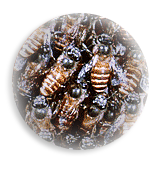
Image is not to scale.

|
General Characteristics:
- Native to Europe, western Asia, and Africa but through human distribution has spread throughout the world
- Colouration is reddish brown with black bands and orange/yellow rings around the abdomen
- More hair is present on the thorax than on the abdomen
- They possess a pollen basket on hind legs
- Length is 10-20mm
- Prefer habitats with large quantities of suitable flowering plants, such as meadows, open wooded areas, and gardens
- Can survive in grasslands, deserts, and wetlands if there is sufficient water, food, and shelter
- They need cavities (e.g. in hollow trees) to nest
- Eusocial insects – task specialization and cooperative care of young
- Colonies consist of one reproductive queen, sterile females (all workers) and males or drones (only responsible for reproduction)
- Workers are smaller than drones but have larger wings, while drones have larger eyes
- Both sterile workers and queen (*All females) possess stingers, but the workers are barbed and usually tear off after use
- Workers demonstrate "age polytheism": newborn workers clean hive cells preparing them for eggs or food, 2-4 day olds perform hive maintenance, 2 week olds repair hive and tend to the queen and larvae, 12-25 day olds guard hive and after about 3 weeks adult bees begin foraging duties
- Hive is created by wax secretions from worker bodies and eggs are laid in cells within the wax
- Partially endothermic - they can warm their bodies and the air temperature by working their flight muscles to produce heat
- Honey bees feed on pollen and nectar collected from blooming flowers
- They also eat honey (stored, concentrated nectar) and secretions produced by other members of their colony
Reproduction:
- Breeding takes place from late spring to early winter
- Queens normally take 16 days to reach maturity, workers take 21 days, and drones take 24 days
- 4 stage life cycle (egg, larva, pupa, adult)
- Queens live 2-5 years
- Queens mate with male drones in flight (as many a 10 per flight)
- Normally only 1 queen per hive and she is the solitary egg producer (Fertile Queen = 1000 eggs per day and 200 000 eggs in her lifetime)
- Colonies reproduce through ‘swarming’ where multiple queens are created and new colonies form hives in adjacent areas
- Eggs hatch in 28-144 hours
- Adult workers will live for 2-4 weeks in the summer, or as long as 11 months if they live through the winter
- Males only survive for 4-8 weeks, and do not live through the winter
Signs of Infestation:
- Nests can be established in a variety of void areas including hollow trees or isolated areas within structures
- Waxy comb structure within the nest is shared with some other wasp species and is not a good indicator of honey bee infestation
- Bees entering and exiting through a specific point can direct an observer to the nesting area
- Flying bees are not an indicator of nesting and are not treatable as these are most likely workers foraging for food
- A PROFESSIONAL SHOULD BE CONTACTED AT ALL TIMES TO IDENTIFY SPECIES AND ENSURE THAT ALL PROVINCIAL AND FEDERAL LEGALITIES ARE OBSERVED CONCERNING TREATMENT
Control Techniques:
- As these bees are farmed by humans, local authorities need to be contacted to ensure that the bees in question do not belong to a licensed farmer
- These insects are very beneficial as they contribute to the pollination of numerous plant species
- Only females can sting and medical treatment should be sought immediately if any signs of allergic reaction is noted
- A PROFESSIONAL SHOULD BE CONTACTED AT ALL TIMES IN THE CASE OF HONEY BEES TO ENSURE THAT PROVINCIAL AND FEDERAL LEGISLATION IS FULLY OBSERVED
- Proper sealing of structures can reduce bee activity within structures
- Bright and colourful flower gardens can be a significant attractor for honey bee workers and should be avoided to inhibit bee activity
Please click here to contact a Focus Pest Control professional to inquire about further treatments for this pest species.
References:
Benett, Gary W., et.al.. Truman’s Scientific Guide to Pest Control Operations. Duluth: Advanstar Communications, 1988. p. 202-203.
Hammond, G., M. Blankenship and K. Francl. 2009. "Apis mellifera" (On-line), Animal Diversity Web. Accessed November 18, 2009 at http://animaldiversity.ummz.umich.edu/site/accounts/information/Apis_mellifera.html.
Disclaimer:
The Focus Pest Control ‘Pest Library’ is an educational resource written largely to educate the general public about common pests in Ontario. The Focus ‘Pest Library’ does not include all species in Ontario, nor does it include the most recent scientific data about species we describe. Though we edit our accounts for accuracy, we cannot guarantee all information in those accounts. While Focus Pest Control staff and contributors provide references to books and websites that we believe are reputable, we cannot necessarily endorse the contents of references beyond our control.
(Back to top)
|


